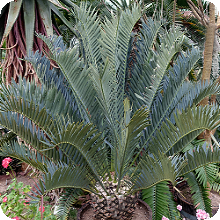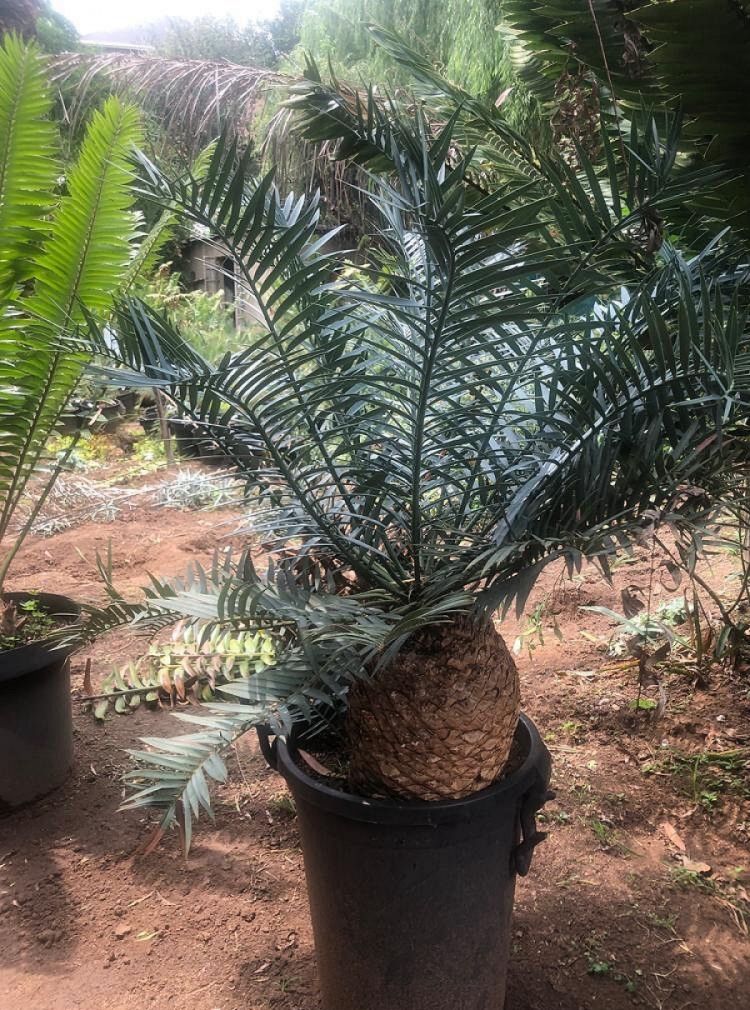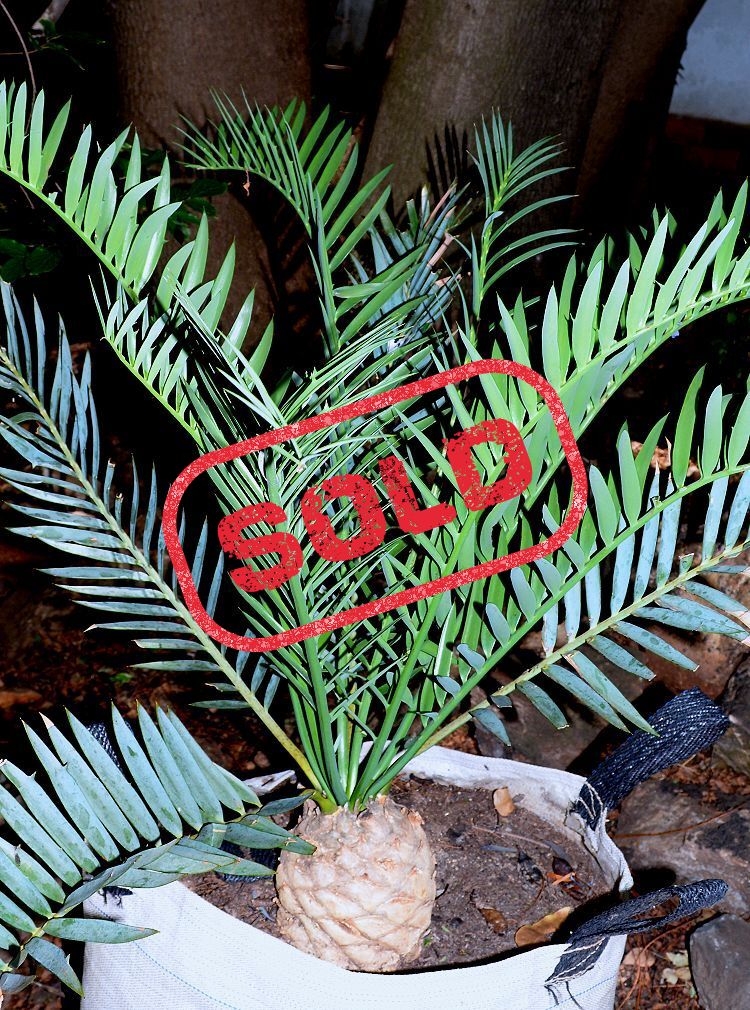| |||
| Division: Cycadophyta |
| Class: Cycadopsida |
| Order: Cycadales |
| Family: Zamiaceae |
| Genus: Encephalartos |
| Species: E. trispinosus |
Conservation Status: |

E. trispinosus
Bushman's River CycadEncephalartos trispinosus occurs in the Eastern Cape Province of South Africa. Subpopulations are found in the Great Fish, the Bushman's and the Kowie River valleys in the Albany, Bathurst, Fort Beaufort and Peddie districts. Occurs from 100 up to 600 m. It grows in arid low succulent shrubland on rocky ridges and slopes. It is found in the shade or in full sun on rocky outcrops.
E. trispinosus develops stems up to 1 x 0.25-0.3 m, which are branched from the base and not necessarily upright, tending to lean over. A mature plant can develop 4 to 6 stems, with a number of suckers emerging at the base of the plant. The leaves, generally grey in colour, vary in size and shade of grey, depending on which population they originate from; they are 0.75-1.25 m long, and are recurved and twist towards the tip. The leaflets consist of 3 lobes with a spine borne at each point.
The cones of this species are bright yellow. One male cone is produced per stem, occasionally two. The cones are 250-350 x 70-80 mm. Female plants produce only one cone per stem and the cones are 400-500 x 180-200 mm . The scales are deeply wrinkled. The colour of the seeds ranges from pale red to orange. The cones emerge in midsummer (January-December in South Africa ).
Male cones are harvested in the autumn (April) and pollination of the female cones takes place in April-May.
Cultivation:
E. trispinosus is one of the slower-growing cycad species but does well in cultivation and will live to a great age provided it is positioned in a sunny situation which is well-drained. It can be used as an accent plant in rockeries, lawns and as a container plant. Ideal companion plants are low-growing aloes such as Aloe arborescens, Carpobrotus and Arctotis.
This species is not tall-growing, suckers freely and forms large, attractive, grey-leaved clumps. It is hardy, withstands frost and does not require a great deal of water.
Propagation of Encephalartos trispinosus can be achieved by sowing seed or by removing well-matured suckers from the mother plant. To produce true-to-type seed it is necessary to hand-pollinate the female cone with pollen harvested from a male cone of the same species. Germination ranges from 30-40%, on average. The seed is sown in spring on a bed of clean coarse sand which has bottom heat of 25-28°C. Within two months the seed germinates, producing a radicle followed by the leaves and 10 months later the seedlings are large enough to be removed and potted into 3-litre plastic sleeves, using a well-drained growing medium. The seedlings are watered sparingly until established.
Propagation by division involves removing well-developed suckers of approximately 250 mm in diameter from the mother plant. Early spring is an ideal time, when all leaves are removed from the sucker which is then carefully pulled away from the main stem. The sucker needs to be left for two weeks so that the wound can dry before planting in clean sand to encourage root development. Once well-rooted, the sucker can be planted out in the open ground.
| full sun | blue | very low watering | slow growth | frost-hardy | common |
E. trispinosus is one of the slower-growing cycad species but does well in cultivation and will live to a great age provided it is positioned in a sunny situation which is well-drained. It can be used as an accent plant in rockeries, lawns and as a container plant. Ideal companion plants are low-growing aloes such as Aloe arborescens, Carpobrotus and Arctotis.
This species is not tall-growing, suckers freely and forms large, attractive, grey-leaved clumps. It is hardy, withstands frost and does not require a great deal of water.
Propagation of Encephalartos trispinosus can be achieved by sowing seed or by removing well-matured suckers from the mother plant. To produce true-to-type seed it is necessary to hand-pollinate the female cone with pollen harvested from a male cone of the same species. Germination ranges from 30-40%, on average. The seed is sown in spring on a bed of clean coarse sand which has bottom heat of 25-28°C. Within two months the seed germinates, producing a radicle followed by the leaves and 10 months later the seedlings are large enough to be removed and potted into 3-litre plastic sleeves, using a well-drained growing medium. The seedlings are watered sparingly until established.
Propagation by division involves removing well-developed suckers of approximately 250 mm in diameter from the mother plant. Early spring is an ideal time, when all leaves are removed from the sucker which is then carefully pulled away from the main stem. The sucker needs to be left for two weeks so that the wound can dry before planting in clean sand to encourage root development. Once well-rooted, the sucker can be planted out in the open ground.
Available E. trispinosus at Africa Cycads:
|
|
|
| ||||
|
|
|
| ||||
|
|
|
|












